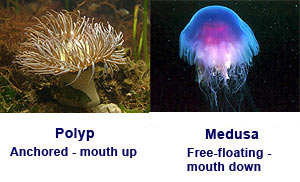Cnidaria
Cnidaria is a phylum containing over 9,000 species found only in aquatic and mostly marine environments.
All cnidarians have radial symmetrical. There are two major body forms among the Cnidaria - the polyp and the medusa. Sea anemones and corals have the polyp form, while jellyfish are typical medusae. When you look at them, you can see that these body forms are the same except that one is upside down. |
 |
| |
|
Diffusion is the movement of a material (red circles) from regions of higher concentration (Side A) to regions of lower concentration (Side B) until equilibrium is reached (same number of particles move from Side A to Side B as move from Side B to Side A). Diffusion is a natural process caused by the random movement of particles but is only useful to very small (or thin) organisms (ones which have a large surface area compared to their volume) where the material in higher concentration does not have far to move.
Cnidaria do not have a brain or groups of nerve cells ("ganglia"). The nervous system is a decentralized network (‘nerve net’), with one or two nets present. They do not have a head, but they have a mouth, surrounded by a crown of tentacles. The tentacles are covered with stinging cells (nematocysts).
|

|
| |
|
Nearly all cnidaria are predators, their nematocysts can paralyze and kill prey much larger than them. Small sensory hairs near the nematocysts are sensitive to vibrations in the water. Any prey swimming past can trigger the nematocyst which shoots out the barb. This penetrates the prey's outer covering and injects it with venom. The prey is then moved to the mouth by a tentacle.
Their prey can range in size from plankton to animals several times larger than themselves. Some obtain their energy from algae that that live in their bodies and a few are parasites. Other Cnidaria, including the corals, get their nutrients from symbiotic algae within their cells.
Predators of Cnidaria include sea slugs, sea stars (for example, the Crown of Thorn which can devastate coral reefs), nudibranchs, fish including butterfly fish and parrot fish, which eat corals and marine turtles and sunfish, which eat jellyfish. Plastic bags floating in the oceans are dangerous to turtles which often can mistake them for jellyfish and their guts can become blocked by them. |

|
| |
|
For example coral, inside the sac of each coral polyp lives a singlee-celled algae called zooxanthellae. The algae produces oxygen and energy (sugars) that the coral polyp needs to live and, in return, the polyp produces carbon dioxide and other substances the algae needs. That is why coral reefs grow so near the surface of the water where the algae can get sunshine for photosynthesis.
Many Cnidaria live in colonies made up of large numbers of individuals joined together in some way. These individuals (called zooids) can either be directly connected by tissues or share a common exoskeleton made from chiton or calcium carbonate.
In the Cnidaria sexual reproduction often involves a complex life cycle with both polyp and medusa stages. For example in Scyphozoa (jellyfish) and Cubozoa (box jellies) a larva swims until it finds a good site, and then becomes a polyp. This grows normally but then absorbs its tentacles and splits horizontally into a series of disks that become juvenile medusae, a process called strobilation. The juveniles swim off and slowly grow to maturity, while the polyp re-grows and may continue strobilating periodically. The adults have gonads in the gastroderm, and these release ova and sperm into the water in the breeding season. |

|
| |
|
Other Cnidaria have shorter forms of this cycle, for example cubozoan polyps have only one medusa stage. All Cnidaria can reproduce asexually by various means, in addition to regenerating if their bodies are divided into segments or are attacked by predators. Some produce buds, others divide down the middle, others do both.
Cnidarians range in size from Hydra, 5–20 millimetres to the Lion's mane jellyfish, which may exceed 2 metres in diameter and 75 metres in length.
|

|
| |
|
References
http://en.wikipedia.org/wiki/Cnidaria
http://tolweb.org/Cnidaria
www.ucmp.berkeley.edu/cnidaria/cnidaria.html
www.biodiversityexplorer.org/mm/cnidaria/
http://www.jellywatch.org/
Thanks to
I would sincerely like to thank the many members of the Flickr community who have given me permission to use their wonderful images for this unit. Their contributions really make this unit come alive!
Next: Anthozoa ... |
|